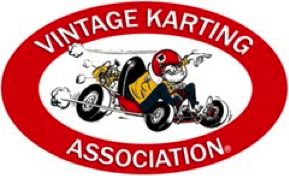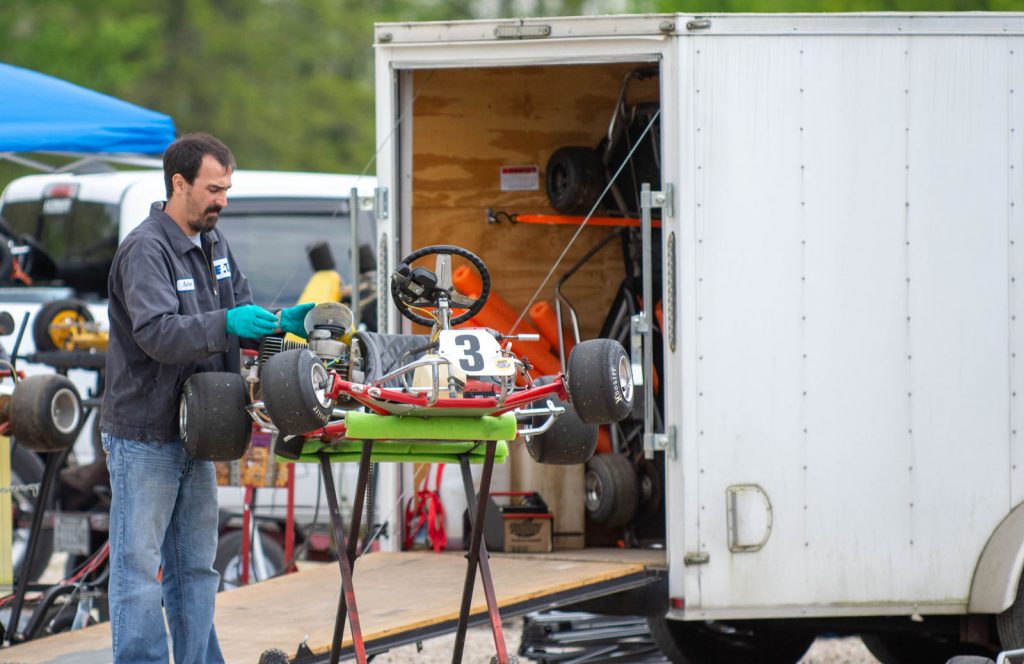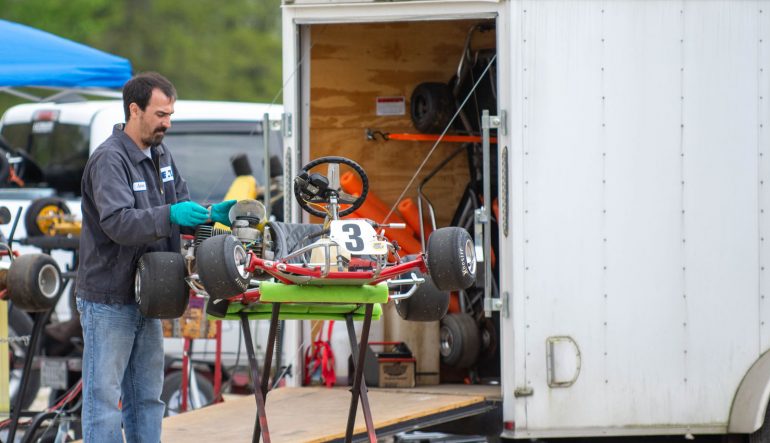By John Copeland

Last month we looked at different types of engine oils commonly used in 2-cycle engines for Vintage (and modern) karting. We looked at the 3 most common types of 2-cycle oils; petroleum oil, Castor-based oil, and synthetics, and what the pro and cons of each are. Now let’s tackle the question fuel/oil ratio. In basic terms, we’ll look at how much oil per gallon of fuel will yield the best performance and the best protection for your engine.
Fuel/oil ratios are typically expressed as 16:1 or 20:1, or some other combination of numbers. This means that, in the case of 16:1, you have 16 ounces of fuel for every 1 ounce of oil. Since a gallon of fuel contains 128 fluid ounces, that means that, to get a 16:1 ratio, you need to divide 128 by 16. 128/16=8 So, to get a 16:1 ratio of fuel to oil you need to use 8 ounces of oil per gallon. For smaller fuel quantities, use this formula; 1 quart of fuel contains 32 fluid ounces so, to get a 16:1 ratio, divide 32 by 16. 32/16=2 So, you’ll need 2 ounces of oil per quart.
If you are accustomed to using metric measurements, the process is essentially the same. 1 liter of fuel contains 1000 milliliters (ml). Divide that by 16 to get your 16:1 ratio and you get 62.5 ml of oil per liter of fuel.
If you want to run some other ratio, like 20:1 or 50:1, the process is exactly the same; divide the quantity of fuel (128 oz per gallon, 32 oz per quart, 1000 ml per liter) by the first number in your ratio and that give you the appropriate amount of oil for that volume of fuel.

But what is the best ratio to run? Well, everybody (and especially every engine builder) has their own opinion. And oil manufacturers have their own recommendations as well. More about that later.
Before we get into the numbers, let’s go back to last month’s discussion about what the oil in your fuel does. The oil’s primary job is to keep metal parts from touching each other. Bearings, seals, piston-to-cylinder-wall; it’s critical that these parts be bathed in a thin film of oil so they don’t scratch, scuff, or overheat. This is particularly important for the bottom rod bearing. Engines with “caged” bottom rod needle bearings are extraordinarily highly stressed. That means that the “point load” pressure on those roller needles is very high. Lack of adequate lubrication, or lubrication that lacks adequate film strength, will quickly lead to bottom rod bearing failure. But the oil serves another very important function; it helps improve compression by improving the “seal” between the ring and the cylinder wall.
All this means, in a very real sense, that more oil, and better oil, is almost always better for the life and performance of your engine. The only limiting factor in how much oil you can run is when excess oil begins to foul spark plugs. In his book The Two Stroke Tuner’s Handbook (the absolute Bible for 2 cycle engine builders) Gordon Jennings wrote “When it comes to oil, more is always better.” But, that being said, every engine builder will have his own opinion about oil ratios. They know how they set their engines up, so I would encourage you to follow their advice.
Now a word about oil manufacturer’s ratio recommendations. Oil manufacturers produce their products to serve a large and diverse market of end-users. Of the vast array of 2-cycle-powered devices (outboard motors, motorcycles, jet-skis, etc.) kart engines are just a small fraction of the market. So when you see a manufacturer that promotes their oil as “50:1” or “100:1”, that may work in some (or most) applications.
But it doesn’t mean it will work for what we do in karting.
Our engines, by virtue of how they are designed, need more oil than other applications. If you want to experiment with higher fuel to oil ratios, you do so at your peril. But I can tell you this; after more than 50 years of karting, hundreds of races, and countless hours on the dyno, 16:1 is the ratio that has consistently provided the best performance with acceptable engine life.
Next month we’ll dig into another tech topic. Until then, we hope to see you at the track.

